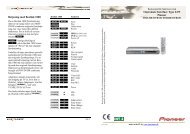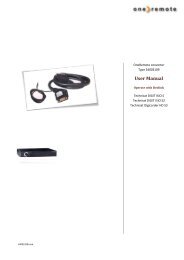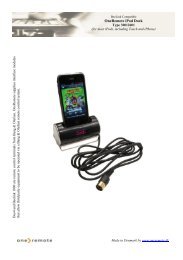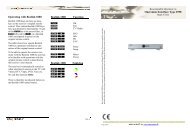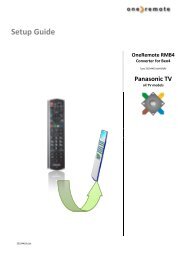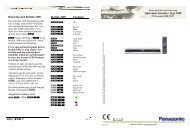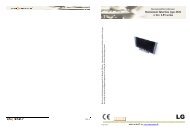OneRemote User guide English
OneRemote User guide English
OneRemote User guide English
Create successful ePaper yourself
Turn your PDF publications into a flip-book with our unique Google optimized e-Paper software.
Beo4 and Beolink 1000 are remote control terminals from Bang & Olufsen. <strong>OneRemote</strong> supplies interface<br />
modules that allow third party equipment to be operated via a Bang & Olufsen remote control system.<br />
6102UKu1<br />
Beocompatible Operation via<br />
Oneremote Interface Type 6102<br />
Viasat HD<br />
Pace TDS460NV/ Pace TDS850NV/ Pace DS830NV<br />
Samsung DSB-H670N / Strong SRT<br />
Made in Denmark by www.oneremote.dk
Operating with Beo4 and Beo5<br />
Beo4 and Beo5 do not have as many keys<br />
as this receiver’s original remote control.<br />
Thus certain Beo4/ Beo5 keys have got<br />
alternative functionality.<br />
To get to this Ohas to be pressed first,<br />
i.e. Ofollowed by 1 corresponds to<br />
info on the receiver’s own remote control.<br />
The table to the right shows how special<br />
Beo4/ Beo5 key operations translate to<br />
operations of the original remote control.<br />
To get the most of operating the receiver<br />
with a Bang & Olufsen remote control, the<br />
user has to be familiar with operations with<br />
the original remote control as described in<br />
the receiver’s user manual.<br />
Power on the receiver<br />
The receiver automatically powers up,<br />
when the source is pressed on beo4, which<br />
the bee2 controller is programmed for.<br />
Usually this source might be s,<br />
T, f or something else.<br />
Fabric settings are f.<br />
*1 It is possible to exchange the up/ down arrow the<br />
functions with the blue and yellow buttons. This is<br />
done with an option, refer to the installation pages.<br />
*2 As the direct function of the coloured buttons on<br />
the Beolink remote control has been reassigned to<br />
other functions, Ohas to be pressed before these<br />
buttons, to get to the colour function.<br />
oE Red function<br />
oQ Green Function<br />
oW Yellow function<br />
oR Blue function<br />
Beo4/ Beo5 Daily operation<br />
OO OK<br />
W*2 *1 P+<br />
R*2 *1 P-<br />
Q*2 EPG<br />
E*2 Back<br />
m Setup<br />
Harddrive operation<br />
o Play press 1 second. *3<br />
o0 Alternative play. *3<br />
q Stop<br />
o q Pause<br />
oA Rewind<br />
oS Forward<br />
rr Record<br />
Other operation<br />
o1 info<br />
o2 Ticket<br />
o3 Planner<br />
o4 Help/ Options<br />
w Power off<br />
o9 Power manual<br />
oE Internal Text TV<br />
*3 First generation Beo4 and other remote controls do<br />
not send Play using the O button. Use the<br />
alternative operation or have a B&O dealer upgrade<br />
the Beo4.
Congratulations<br />
With your bee2 controller from www.oneremote.dk you now<br />
can fully operate your receiver using your Bang & Olufsen<br />
remote control terminal, via a beeLINK system bus.<br />
Beolink1000, Beo4 or Beo5 remote controls can be used. This<br />
<strong>guide</strong> explains how.<br />
This BeeLINK2 controller is ready for use, plug & play. See the<br />
opposite page regarding daily operation.<br />
Some operations can be altered, to improve interaction with<br />
other controllers or to your convenience. Refer to the installation<br />
section further on, if changes are needed.
BeeLINK - How it works<br />
The <strong>OneRemote</strong> beeLINK system is based on a 455 khz IR-receiver placed in the room.<br />
Via a beeLINK amplifier it distributes control data to one or many different beeLINK<br />
controllers or BeeLINK compatible devices, each designed for a specific purpose. One<br />
controller is used for the TV, another controller for the DVD, a third for a beamer and so<br />
on.<br />
The BeeLINK system lets you control many devices, in a logic way. A single press on the<br />
DTV button on the Beo4 might operate the TV, a receiver, an amplifier and a HDMI<br />
switch at the same time. There are many solutions.<br />
A beo4 remote control is not equipped with many keys, so we have designed a ‘layout’<br />
that works logically, even when shifting control between different non B&O devices. To<br />
get a common layout for many devices, we therefore needed to redefine a few of the beo4/<br />
beo5 buttons to other functions:<br />
• Coloured buttons.<br />
To make room for more important functions, we have moved the coloured<br />
buttons, to a lower layer. To send a ‘red’ button command O must be pressed<br />
first. The same goes with the other 3 coloured buttons. This way we can assign<br />
other functions to the coloured buttons, when pressed without a preceding go. In<br />
a <strong>OneRemote</strong> environment the red button is used as Back, Backup or return. The<br />
green button is used as EPG, Guide or similar. Finally the blue and yellow button<br />
is used for programme stepping.<br />
• Programme stepping, up/ down manoeuvring in menu’s.<br />
Most set top boxes and TV’s has 4 arrow buttons for moving up, down, left and<br />
right, in on screen menus. In addition to these buttons they also have separate<br />
programme stepping buttons for zapping through programmes. B&O remote<br />
controls do not include separate buttons for programme zapping.<br />
We therefore have assigned the blue and the yellow buttons to function as<br />
programme stepping buttons, in our basic setup. The four up, down, left and right<br />
buttons have been assigned for manoeuvring in on screen menus, in our basic<br />
setup.<br />
It is possible to use the up and down arrow for programme stepping, refer to the<br />
installation section.<br />
• Go or Record shifted operation.<br />
Some of the buttons has 2 or three functions. To get to these they have to be<br />
preceded with O or r. Which buttons has secondary functions can be<br />
seen in the operating table on page 2.
BeeLINK basics – the link amplifier.<br />
To receive the IR data emitted from a Bang & Olufsen remote control, a B&O IR-receiver<br />
is often used. If there is already one IR-receiver in the room, this can also be used to feed<br />
the BeeLINK bus. Normally there is no need for two IR receivers in the same room.<br />
A Bang & Olufsen IR-receiver connected to the<br />
BeeLINK link amplifier with four BeeLINK<br />
outputs.<br />
Four BeeLINK controllers can be connected to<br />
this link amplifier. One or more BeeLINK splitters<br />
can be inserted to add outputs for more<br />
controllers.<br />
The shown 700mA power supply is capable of<br />
driving the IR-receiver, the link amplifier and up<br />
to 15 attached BeeLINK controllers.<br />
This basic setup shows the core of a BeeLINK installation. Up to four BeeLINK<br />
controllers or BeeLINK compatible devices can be connected to this linkamplifier.<br />
BeeLINK basics – distribution of power and data.<br />
The BeeLINK bus distributes the IR-data, received with the attached IR-receiver. It also<br />
distributes 12 volt power from the attached power supply.<br />
The cable used is ordinary CAT5 type cable with RJ45 plugs. The same type used for<br />
computer networks. We chose this type as it is inexpensive and easy to crimp plugs on,<br />
with inexpensive tools that all installers use as standard. Also it is well suited for data<br />
transmission, and it provides us with extra leads for power supplying of the attached<br />
BeeLINK controllers. Finally many modern house installations use the same connectors,<br />
making installation even easier.<br />
Note !<br />
A BeeLINK bus must ONLY be connected to BeeLINK components.<br />
If connected to LAN or other systems,<br />
there is a great risk to damage these systems.
The BeeLINK bus is a parallel bus type. Passive splitters therefore can be used, to make a<br />
network of any shape. If many controllers or very long cables are used, it might be<br />
necessary to add more power supplies, placed closer to the controllers that lack power.<br />
Using this parallel structure each BeeLINK controller receives the IR-data<br />
simultaneously. Every controller has its own microcomputer, living its own life.<br />
Although some of the controllers can ‘talk’ to each other, most controllers operate fully on<br />
their own.<br />
BeeLINK2 – installation<br />
The BeeLINK2 controller gets its power supply and control data, via the CAT5 cable<br />
from a BeeLINK amplifier. The BeeBus.<br />
Once connected to the BeeBus the BeeLINK2 controller only needs an IR-emitter to<br />
operate the device it has been designed for. The IR-emitter emits the same IR data as the<br />
device’s own remote control.<br />
Emitted IR data is in fact pure light at a frequency just out of the spectrum that the human eye is able to see.<br />
It is short flashes of light, a bit like when sending morsing codes using a flashlight.<br />
The emitter must be stuck on the device, nearby the TVs IR-receiver. It must be placed so<br />
the IR receiver in the device is able to see the emitted light from the IR-emitter.<br />
The IR-emitter can be placed inside the device, if you want to avoid having it on the<br />
outside, as long as the IR-receiver is able to see the light from the emitter.<br />
A BeeLINK2 controller connects to the<br />
BeeBUS via a CAT5 cable, for power supply<br />
and control data.<br />
Typically an IR-emitter sends the commands<br />
to the TV.<br />
The BeeLINK2 controller can be placed by the device or in another room. IR emitters are<br />
available in lengths of 1, 5 and 10 meters. In addition extension cords can be used. An IRemitter<br />
can be extended to more than 30 meters.<br />
A BeeBUS CAT5 cable may exceed more than 75 meters without additional amplifiers.
BeeLINK2 connections.<br />
The IR/ sense socket is output for the IR-emitter that sends IR to the device to be<br />
operated. In some cases this socket is also used for sensing purposes. Sometimes the<br />
BeeLINK2 controller needs to know if the device is powered up or not.<br />
In some cases this socket is used for other serial communication like RS-232 instead of IR<br />
control.<br />
Prog switch is a push button that must be activated to initiate a programming sequence, as<br />
described in the option programming chapters.<br />
Do not use socket is for firmware updating of the controller. If used for anything else, the<br />
controller may be damaged.<br />
LED indicates different operating modes:<br />
Red-green flash: No data has been received since power has been applied<br />
Red flash: The controller is in option programming mode.<br />
Red: The controller is active.<br />
Green: The controller is inactive.<br />
Short light off: When the controller sends data, the LED turns off 1 sec.<br />
A BeeLINK2 controller connects to the BeeBUS via a RJ45<br />
connector and CAT5 cable.<br />
Warning:<br />
If connected to a computer network,<br />
this is likely to be damaged.<br />
Connect only to a BeeLINK bus.
BeeLINK Active option.<br />
As all controllers on the BeeLINK bus are receiving all the IR-data simultaneously, every<br />
controller must know when to go active and when to go inactive. Sometimes two or more<br />
controllers are active at the same time.<br />
A BeeLINK 2 controller is used to operate a TV, a satellite receiver, a DVD-player, a<br />
projector or similar devices. Each controller is specifically made for one device.<br />
From factory a BeeLINK2 controller is set to go active on a source button like t or<br />
d. The controller can be programmed to go active on another source, setting the<br />
Active option.<br />
Your BeeLINK2 controller needs to know when you want it to go active, in your setup.<br />
You need to program it with an Active option.<br />
Option Function<br />
f 0r f turns on the receiver.<br />
f 1r f + 1 turns on the receiver.<br />
f 2r f + 2 turns on the receiver.<br />
An option programming sequence is initiated by pressing the little red switch on the BeeLINK2 controller, until<br />
its LED starts flashing. Hereafter the 3 digit option code must be entered with the B&O remote control.<br />
Up to 10 receivers can be controlled this way, using the same source. This could be useful<br />
when you have more than one device of the same type.<br />
When the BeeLINK2 controller goes active, its LED will turn red to indicate this. When<br />
another source is selected, the controller will go inactive and the LED turn green.<br />
As the controller goes active, it will usually turn on the device, if it is not already turned<br />
on.<br />
Setup with 3 receivers and a PS3 playstation,<br />
attached to both a TV and a projector.<br />
One example of operation could be:<br />
t1 Operate projector<br />
t2 Operate TV<br />
f1 Operate DVB-S<br />
f2 Operate DVB-T<br />
T Operate DVB-C<br />
f Operate PS3
Programme Zapping option<br />
In a BeeLINK environment the buttonsW and Rare being used for programme<br />
stepping and to manoeuvre up and down in an on screen menu.<br />
This is the basic <strong>OneRemote</strong> layout and compatible with other <strong>OneRemote</strong> controllers.<br />
Some people prefer the programme zapping buttons on the up and down buttons. The<br />
programme zapping option, make it possible to change the function of these buttons.<br />
If the user would give it a fair chance, trying out the <strong>OneRemote</strong> layout, it is not likely<br />
that he would make use of this option. The <strong>OneRemote</strong> layout adds much perspective to<br />
many OSD menus on many devices, and makes sense once fully understood. But we are<br />
up against habits, which we all wants to hang on to, so...<br />
Option Function<br />
090 W and Rare used for programme zapping.<br />
091 D and Fare used for programme zapping. Factory setting.<br />
An option programming sequence is initiated by pressing the little red switch on the BeeLINK2 controller, until<br />
its LED starts flashing. Hereafter the 3 digit option code must be entered with the B&O remote control.<br />
Menu button option<br />
If the device is used in a setup that includes a Bang & Olufsen TV, sometimes the use of<br />
the m button gives a conflict.<br />
Some Bang & Olufsen TV act on the m and enters its own TV On Screen Menu<br />
regardless of which source it is set to.<br />
In these setups the Menu button must be disabled on the BeeLINK controllers. Instead of<br />
using the Menu button to access the devices ‘Menu’, use the alternative menu operation<br />
o5.<br />
Option Function<br />
080 Menu button blocked. Use alternative menu operation<br />
081 Menu button enabled.<br />
An option programming sequence is initiated by pressing the little red switch on the BeeLINK2 controller, until<br />
its LED starts flashing. Hereafter the 3 digit option code must be entered with the B&O remote control.
Power off option<br />
Most beeLINK controlled devices will automatically power on, when they are selected.<br />
But it is not always practical if a device automatically powers off, when another source is<br />
selected or the TV is turned off.<br />
An example could be a Satellite receiver that is being used in more than one room. If a<br />
user in a linkroom is watching programmes from the receiver, it is not practical that the<br />
receiver automatically powers off, when the user in the main room turns off the TV or<br />
selects another source. If a recorder has been timed to record from the receiver, it would<br />
also be a problem if the system automatically powers off the receiver.<br />
Many devices use so much time running a booting sequence that you might want them to<br />
never power off, for this reason only.<br />
The PowerOff option makes you select different ways to power off a device. This device<br />
has following PowerOff options available:<br />
Option Function<br />
031 Power off using the w button. Press shortly. *1<br />
032 Power off using the w button. Press 2 seconds for global standby. *1<br />
033 Power off disabled. Use manual power button O9 to power off the device.<br />
An option programming sequence is initiated by pressing the little red switch on the BeeLINK2 controller, until<br />
its LED starts flashing. Hereafter the 3 digit option code must be entered with the B&O remote control.<br />
Tip.<br />
In a setup that includes a TV, this should be set with option 031. Some or all set top boxes should be set with<br />
option 032. When the user turns off the TV after a session, a short press on the standby button will turn off the<br />
TV only, and a long press on standby will turn of all of the set top boxes as well.<br />
*1<br />
Some BeeLINK controllers need to know the power status<br />
from the device, in order to power it on and off<br />
automatically.<br />
This controller uses a <strong>OneRemote</strong> IR-emitter with a DC<br />
type scartplug, to measure on the device. <strong>OneRemote</strong> type<br />
34090051.<br />
The scartplug must be inserted in the devices TV-scart<br />
socket.
Beolink 1000 og Beo4 notes<br />
Beolink 1000 and other early Bang & Olufsen remote controls are not equipped with the<br />
coloured function buttons that have been added to Beo4 and Beo5. The lack of these<br />
buttons makes it difficult to make a good layout, transparent for controlling different<br />
devices. Some operations therefore might be less logical or in some cases not available,<br />
when using these remote controls in a BeeLINK setup.<br />
Some buttons on the Beolink 1000 remote controls, do actually send the same commands<br />
as the new buttons on a Beo4/ Beo5. Other buttons simply has been renamed, but still<br />
sends the same commands.<br />
Beolink 1000 Compares to Beo4/ Beo5<br />
------------------- --------------------------------<br />
hZ Q<br />
hX W<br />
hC R<br />
hV E<br />
o P<br />
v T<br />
h v VTAPE2 /VMEM2 /DVD2<br />
s f<br />
h s d / CDV<br />
h t a<br />
y b<br />
h y AMEM2<br />
For compatibility with older remote controls, a typical <strong>OneRemote</strong> setup uses the<br />
following buttons:<br />
Beolink 1000 Typical BeeLINK use<br />
---------------- -----------------------------------------<br />
g Back, Backup e.t.c.<br />
p g EPG, Guide e.t.c.<br />
x EXIT.<br />
p5 Menu.<br />
p9 Manual power.



